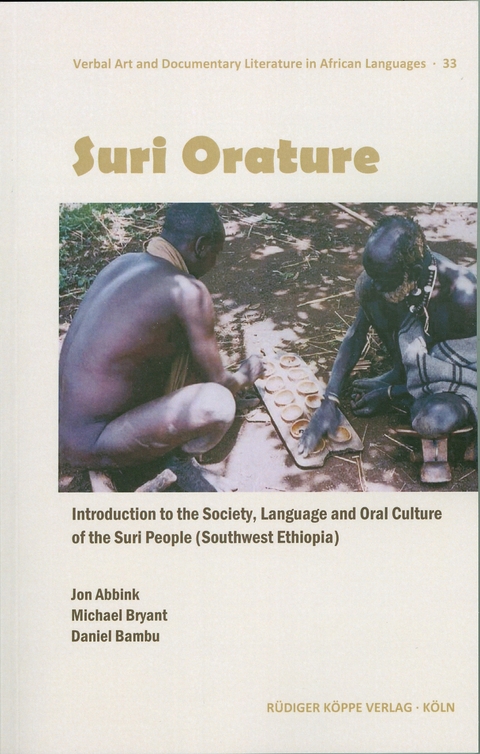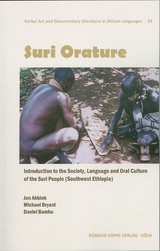Suri Orature
Introduction to the Society, Language and Oral Culture of the Suri People (Southwest Ethiopia)
Seiten
2013
Köppe, R (Verlag)
978-3-89645-289-4 (ISBN)
Köppe, R (Verlag)
978-3-89645-289-4 (ISBN)
- Titel leider nicht mehr lieferbar
- Artikel merken
Das vorliegende Werk über die Land- und Viehwirtschaft betreibenden Suri Südwest-Äthiopiens ist eine bahnbrechende Zusammenstellung historischer und sprachwissenschaftlicher Überblicke sowie einer Auswahl mündlich überlieferter Texte einer bislang kaum dokumentierten Ethnie. Die verschiedenen Genres der Suri-Oratur werden in einer kommentierten Form dargeboten. Damit stellt die Studie neues Informations- und Quellenmaterial zur Verfügung, das sowohl für Wissenschaftler und eine interessierte Öffentlichkeit als auch die Gemeinschaft der Suri selbst von Nutzen sein kann.
Im Laufe der letzten zwei Jahrzehnte entwickelten sich die Suri (etwa 27.000 Sprecher) – aufgrund ihrer spektakulären Körperbemalung und anderer dekorativer Elemente ihrer materiellen Kultur – zu einem beliebten Touristenobjekt und wurden in zahllosen modernen Reisereportagen, Bildbänden, Magazinen, Werbespots und Filmen abgelichtet und dargestellt. Diese Medien, in erster Linie ausgerichtet auf eine attraktive visuelle Symbolik und die Übertreibungen und Klischees der Reiseliteratur, stellen diese Menschen jedoch nicht immer auf eine informative und verantwortliche Art und Weise dar.
Die Autoren dieses Buchs haben hingegen das Anliegen, die Suri als eine zeitgenössische Gesellschaft im Wandel zu präsentieren, Aspekte ihrer Gesellschaftsordnung, des historischen Hintergrundes und der Lebensweise aufzuzeigen und die bestmögliche Einführung in ein besseres Verständnis dieser faszinierenden Ethnie zu liefern. Ebenfalls weisen sie auf einige der Probleme hin, mit denen sich die Gesellschaften Südwest-Äthiopiens in dieser historisch bedeutsamen Zeit des Wandels, mit all seinen neuen ökonomischen, sozialen und kulturellen Herausforderungen, konfrontiert sehen.
INHALT / CONTENTS
Jon Abbink / Michael Bryant: Introduction and Acknowledgements.
Part 1 – Suri Society:
Jon Abbink: Introduction to the Society and History of the Suri People.
Part 2 – Suri Language:
Michael Bryant: The Suri Language – A Condensed Description.
Part 3 – Orature – Samples from the ‘Literature’ of an Oral Culture:
Introduction / Folk Tales / Public Meetings / Traditional Suri Songs (Favourite Bull Song and Age-initiation Ritual Song).
Part 4 – A Suri View on Suri Life and Society – Daniel Bambu’s Accounts:
Daniel Bambu: From my Perspective as a Suri – Narratives on Suri Life.
Jon Abbink / Michael Bryant: Introduction to the Narratives
The Narratives.
***
This book on the agro-pastoralist Suri of Southwest Ethiopia is a pioneering collection on a relatively under-documented people, containing historical and linguistic overviews as well as a first selection of Suri oral texts. Several genres of the orature of the Suri are presented in an annotated form. The book thus provides new context information and oral source material of possible wider use to scholars and the wider public as well as to the Suri themselves.
Over the past two decades the Suri – with their spectacular body painting and other customs of decorative culture - have become known as a prime object of the tourist gaze, and were projected in countless modern travel accounts, photo books, magazine pictures, advertisements, and films. These media, primarily being geared to attractive visual imagery and travel literature hyperboles, do not always depict them in an informative or responsible way.
This book has the more modest aim of presenting the Suri as a contemporary people in a process of survival and change, presenting elements of their social organization historical background and way of life, and provides the best introduction to a better understanding of this fascinating group. The authors also indicate some of the problems faced by the Suri in this historically crucial time of change, where many new economic, social and cultural challenges face Southwest Ethiopia and its peoples.
REVIEWS
“For people who want an excellent overview of Suri society, language, and oral culture, this thoughtful and well-written book will be very useful. [...]
This book is clearly meant to serve as an introduction to Suri society and oral culture. The book also shows that anthropology and linguistics are not only for a small group of experts, but are also useful to educators, students, and the Suri community in general. As the Suri transition into new – and often unfamiliar – sociocultural contexts, in which their involvement in government school-based education will no doubt increase, the pedagogical value of the book for future literacy programs in Suri will be important. [...]
As an anthropologist deeply concerned with the quality of future education projects for agro-pastoralists in South Omo, and especially their ability to fulfill the practical needs of the community, I am grateful to the authors (Abbink, Bryant, and Bambu) for showing readers in such a clear and straightforward manner that a basic understanding of Suri language, society and oral culture is not only useful and interesting in its own right, but a practical first step towards protecting linguistic diversity and cultural heritage in southwest Ethiopia.”
(Shauna LaTosky in “Anthropos” 110/2, 2015, 591-592)
“‘Suri Orature’ succeeds well in its aim to provide an introduction to the society, language and oral culture of the Suri people, and I look forward to future editions of Suri oral texts.”
(Jean Lydall in “Aethiopica” 18/2015, 289-291)
Im Laufe der letzten zwei Jahrzehnte entwickelten sich die Suri (etwa 27.000 Sprecher) – aufgrund ihrer spektakulären Körperbemalung und anderer dekorativer Elemente ihrer materiellen Kultur – zu einem beliebten Touristenobjekt und wurden in zahllosen modernen Reisereportagen, Bildbänden, Magazinen, Werbespots und Filmen abgelichtet und dargestellt. Diese Medien, in erster Linie ausgerichtet auf eine attraktive visuelle Symbolik und die Übertreibungen und Klischees der Reiseliteratur, stellen diese Menschen jedoch nicht immer auf eine informative und verantwortliche Art und Weise dar.
Die Autoren dieses Buchs haben hingegen das Anliegen, die Suri als eine zeitgenössische Gesellschaft im Wandel zu präsentieren, Aspekte ihrer Gesellschaftsordnung, des historischen Hintergrundes und der Lebensweise aufzuzeigen und die bestmögliche Einführung in ein besseres Verständnis dieser faszinierenden Ethnie zu liefern. Ebenfalls weisen sie auf einige der Probleme hin, mit denen sich die Gesellschaften Südwest-Äthiopiens in dieser historisch bedeutsamen Zeit des Wandels, mit all seinen neuen ökonomischen, sozialen und kulturellen Herausforderungen, konfrontiert sehen.
INHALT / CONTENTS
Jon Abbink / Michael Bryant: Introduction and Acknowledgements.
Part 1 – Suri Society:
Jon Abbink: Introduction to the Society and History of the Suri People.
Part 2 – Suri Language:
Michael Bryant: The Suri Language – A Condensed Description.
Part 3 – Orature – Samples from the ‘Literature’ of an Oral Culture:
Introduction / Folk Tales / Public Meetings / Traditional Suri Songs (Favourite Bull Song and Age-initiation Ritual Song).
Part 4 – A Suri View on Suri Life and Society – Daniel Bambu’s Accounts:
Daniel Bambu: From my Perspective as a Suri – Narratives on Suri Life.
Jon Abbink / Michael Bryant: Introduction to the Narratives
The Narratives.
***
This book on the agro-pastoralist Suri of Southwest Ethiopia is a pioneering collection on a relatively under-documented people, containing historical and linguistic overviews as well as a first selection of Suri oral texts. Several genres of the orature of the Suri are presented in an annotated form. The book thus provides new context information and oral source material of possible wider use to scholars and the wider public as well as to the Suri themselves.
Over the past two decades the Suri – with their spectacular body painting and other customs of decorative culture - have become known as a prime object of the tourist gaze, and were projected in countless modern travel accounts, photo books, magazine pictures, advertisements, and films. These media, primarily being geared to attractive visual imagery and travel literature hyperboles, do not always depict them in an informative or responsible way.
This book has the more modest aim of presenting the Suri as a contemporary people in a process of survival and change, presenting elements of their social organization historical background and way of life, and provides the best introduction to a better understanding of this fascinating group. The authors also indicate some of the problems faced by the Suri in this historically crucial time of change, where many new economic, social and cultural challenges face Southwest Ethiopia and its peoples.
REVIEWS
“For people who want an excellent overview of Suri society, language, and oral culture, this thoughtful and well-written book will be very useful. [...]
This book is clearly meant to serve as an introduction to Suri society and oral culture. The book also shows that anthropology and linguistics are not only for a small group of experts, but are also useful to educators, students, and the Suri community in general. As the Suri transition into new – and often unfamiliar – sociocultural contexts, in which their involvement in government school-based education will no doubt increase, the pedagogical value of the book for future literacy programs in Suri will be important. [...]
As an anthropologist deeply concerned with the quality of future education projects for agro-pastoralists in South Omo, and especially their ability to fulfill the practical needs of the community, I am grateful to the authors (Abbink, Bryant, and Bambu) for showing readers in such a clear and straightforward manner that a basic understanding of Suri language, society and oral culture is not only useful and interesting in its own right, but a practical first step towards protecting linguistic diversity and cultural heritage in southwest Ethiopia.”
(Shauna LaTosky in “Anthropos” 110/2, 2015, 591-592)
“‘Suri Orature’ succeeds well in its aim to provide an introduction to the society, language and oral culture of the Suri people, and I look forward to future editions of Suri oral texts.”
(Jean Lydall in “Aethiopica” 18/2015, 289-291)
| Erscheint lt. Verlag | 15.10.2013 |
|---|---|
| Reihe/Serie | Wortkunst und Dokumentartexte in afrikanischen Sprachen ; 33 |
| Mitarbeit |
Herausgeber (Serie): Wilhelm J.G. Möhlig |
| Zusatzinfo | 1 Karte, 6 Farbfotos, 3 Genealogien und Grafiken, zahlreiche Tabellen und Übersichten |
| Verlagsort | Köln |
| Sprache | englisch |
| Maße | 160 x 240 mm |
| Gewicht | 380 g |
| Einbandart | Paperback |
| Themenwelt | Geisteswissenschaften ► Geschichte |
| Geisteswissenschaften ► Sprach- / Literaturwissenschaft | |
| Schlagworte | Äthiopien • Bedrohte Sprachen • Benin • Ethnographie • Fon • Hexerei • Kwasprachen • nilo-saharanisch • Nilo-Saharanische Sprachen • Oralliteratur • Suri • Volkserzählungen • Voodoo • Zauberei |
| ISBN-10 | 3-89645-289-4 / 3896452894 |
| ISBN-13 | 978-3-89645-289-4 / 9783896452894 |
| Zustand | Neuware |
| Haben Sie eine Frage zum Produkt? |
Mehr entdecken
aus dem Bereich
aus dem Bereich
eine kleine Soziologie des Heavy Metal
Buch | Softcover (2023)
Kohlhammer (Verlag)
20,00 €
Projekte, Visionen, Luftschlösser
Buch | Hardcover (2023)
Lehmstedt Verlag
30,00 €




